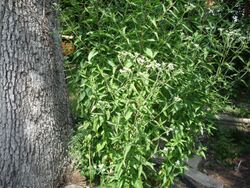Biology:Eupatorium serotinum
| Eupatorium serotinum | |
|---|---|

| |
| Scientific classification | |
| Kingdom: | Plantae |
| Clade: | Tracheophytes |
| Clade: | Angiosperms |
| Clade: | Eudicots |
| Clade: | Asterids |
| Order: | Asterales |
| Family: | Asteraceae |
| Genus: | Eupatorium |
| Species: | E. serotinum
|
| Binomial name | |
| Eupatorium serotinum Michx.
| |
| Synonyms[2] | |
| |
Eupatorium serotinum, also known as late boneset or late thoroughwort, is a fall-blooming, perennial, herbaceous plant native to North America.[3]
Eupatorium serotinum ranges throughout most of the eastern United States, found in every coastal state from Massachusetts to Texas and inland as far as Minnesota and Nebraska. There are reports of one small population in the Canadian Province of Ontario, and other reports of the species on the south side of the Río Grande in northern Mexico.[3][4][5]
Like other members of the genus Eupatorium, Eupatorium serotinum is about one to two meters (40–80 inches) tall. The leaves are typically ovate with serrate margins. The leaf arrangement is alternate, although it can be opposite at some upper nodes. The inflorescence is a flat-topped corymb of many small white flower heads with 9–15 disc florets but no ray florets.[6]
Eupatorium serotinum grows in open sites (either dry or moist), and can hybridize with Eupatorium perfoliatum[3] and other members of the genus Eupatorium. Unlike wind-pollinated plants in this genus, E. serotinum is pollinated by insects.[7]
References
- ↑ "Eupatorium serotinum". NatureServe Explorer. NatureServe. https://explorer.natureserve.org/Taxon/ELEMENT_GLOBAL.2.134670/Eupatorium_serotinum. Retrieved 2022-10-07.
- ↑ "Eupatorium serotinum Michx.". The Global Compositae Checklist (GCC). http://www.theplantlist.org/tpl1.1/record/gcc-154395.
- ↑ 3.0 3.1 3.2 Siripun, Kunsiri Chaw; Schilling, Edward E. (2006), "Eupatorium serotinum", in Flora of North America Editorial Committee, Flora of North America North of Mexico (FNA), 21, New York and Oxford, http://www.efloras.org/florataxon.aspx?flora_id=1&taxon_id=242416536
- ↑ Schmidt, Gregory J.; Schilling, Edward E. (2000). "Phylogeny and biogeography of Eupatorium (Asteraceae: Eupatorieae) based on nuclear ITS sequence data". American Journal of Botany 87 (5): 716–726. doi:10.2307/2656858. PMID 10811796.
- ↑ "Eupatorium serotinum", County-level distribution map from the North American Plant Atlas (NAPA) (Biota of North America Program (BONAP)), 2014, http://bonap.net/MapGallery/County/Eupatorium%20serotinum.png
- ↑ Siripun, Kunsiri Chaw; Schilling, Edward E. (2006), "Eupatorium", in Flora of North America Editorial Committee, Flora of North America North of Mexico (FNA), 21, New York and Oxford, http://www.efloras.org/florataxon.aspx?flora_id=1&taxon_id=112351
- ↑ Victoria I. Sullivan; Joseph Neigel; Bomao Miao (May 1991). "Bias in Inheritance of Chloroplast DNA and Mechanisms of Hybridization between Wind- And Insect-Pollinated Eupatorium (Asteraceae)". American Journal of Botany 78 (5): 695–705. doi:10.2307/2445090.
Further reading
- Bohlmann, F; Zdero, C; King, Rm; Robinson, H (February 1985). "Further Germacranolides from Eupatorium serotinum". Planta Medica 51 (1): 76–77. doi:10.1055/s-2007-969404. PMID 17340414.
- Yatskievych, George Alfred. "Steyermark's Flora of Missouri. Volume 2. Rev. ed." St. Louis: Missouri Dept. of Conservation in assoc. with Missouri Botanical Garden xii, 991p-illus.. ISBN:188724719X En Icones, Maps, Anatomy and morphology, Keys. Geog 3 (1999).
External links
- Photo from the Ozarks Regional Herbarium of Missouri State University
- Photo of herbarium specimen at Missouri Botanical Garden, collected in Missouri in 1993
- From the blog "Nadia's Backyard, a native plant blog in central Missouri.
Wikidata ☰ Q5409977 entry
 |



